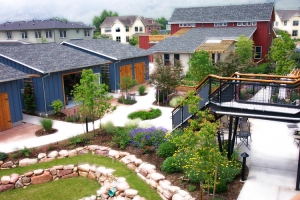A Placemaking Journal
New Urbanist Cohousing: Another Arrow in Developers’ Quivers?
CNU 17, DENVER, CO – New Urbanists attending the 17th annual Congress of New Urbanism gathering in Denver will spend the next four days talking about alls sorts of overlapping , interconnected challenges: The uncertain economy, the implications of climate change, the impact of an aging society on land use planning, to name a few. About an hour away in Boulder are intriguing examples of how designers, developers, and a forward-thinking housing authority might tackle some of those issues.
The Holiday community on Broadway, about 10 minutes from Boulder’s downtown, is a ten-year-old New Urbanist development built on an old drive-in movie site. The local housing authority, Boulder Housing Partners, acquired the property in 1997, and invited five local developers to provide 300-plus units, 40 percent of which had to hit affordability benchmarks.

The general plan – retail and offices fronting Broadway, live-works, town houses, duplexes, and single family units of different scales deeper within the project – would be familiar to most New Urbanists. What sets it apart are two embedded cohousing neighborhoods – Wild Sage, a 34-unit multi-generational neighborhood, and Silver Sage Village, a 16-unit elder cohousing cluster.
Cohousing is an imported-from-Denmark approach to community building that reverses the usual relationship between resident and developer by encouraging the formation of a virtual neighborhood of people who work out how they intend to live with one another before they move in, or even choose the setting in which they’ll live. They maintain separate living units but share maintenance chores and a common house where they dine together at least a couple times a week. It’s part commune, part condo, all community. For a more complete explanation and list of cohousing communities in the US, go here.
Before the economy went into the dumps, cohousing was attracting more and more interest, particularly elder cohousing, which seems a far more attractive way to age in place than in a car-centric suburb. Last month, USA TODAY’s Haya el Nasser profiled life at Silver Sage. And the movement is still big enough to stage its own national get-together, June 24-28, in Seattle.
That appeal to community makes cohousing a natural ally, a potential nesting component, in New Urbanist projects all over the country. Jim Leach, president of Wonderland Development Company credits the fast start of the whole Holiday project to the enthusiasm Wild Sage’s residents brought to the project. And demand for units in Silver Sage Village boosted market-rate prices over the $500,000 mark for some units.
Is this something developers, who could use all the jump starts they can find in the current environment, should be paying more attention to?
Certainly Jim Leach and architect Bryan Bowen, who designed the two Holiday cohousing clusters, think so.
— Ben Brown





